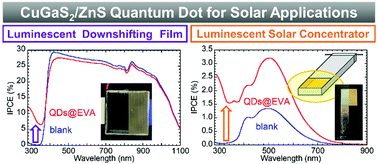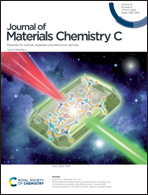Bandgap-tuned fluorescent CuGaS2/ZnS core/shell quantum dots for photovoltaic applications†
Abstract
This work investigated CuGaS2 (CGS)/ZnS quantum dots (QDs) as fluorescent materials for a luminescent downshifting (LDS) layer and a luminescent solar concentrator (LSC) with a single-crystalline silicon (sc-Si) solar module. The bandgap of the CGS/ZnS QDs was adjusted to ∼3.1 eV by changing the molar ratio of Cu/Ga, and in so doing a transparent and colorless LDS layer that converted near-ultraviolet (UV) light to visible light was fabricated. The resulting QDs, which exhibited a high photoluminescence quantum yield of 73%, were embedded in ethylene-vinyl acetate (EVA) copolymer resin to fabricate a QDs@EVA film. The short-circuit current (ISC) of the sc-Si solar module under simulated solar light decreased from 39.35 mA to 38.30 mA (−2.7%) by using the QDs@EVA film instead of an EVA film without QDs. Correspondingly, the photoelectronic conversion efficiency (η) changed from 18.07% to 17.56% (−2.8%). The decreased photocurrent was because of light scattering by aggregated QDs, and overcame the wavelength-conversion effect of the LDS film. In contrast, the QDs@EVA film was effective for LSC because the ISC and η relatively increased by +77.7% and +96.2%, respectively. The visible light emitted by the UV-excited QDs and the visible light scattered by the QDs contributed to the photoelectric conversion.



 Please wait while we load your content...
Please wait while we load your content...